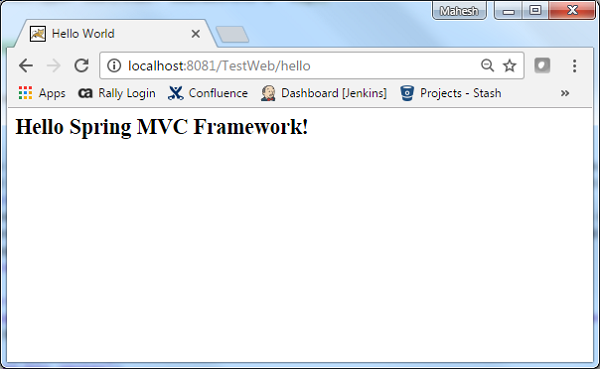Spring MVC - Esempio di mappatura di più resolver
Nel caso in cui si desideri utilizzare un resolver a vista multipla in un'applicazione Spring MVC, è possibile impostare l'ordine di priorità utilizzando la proprietà order. L'esempio seguente mostra come utilizzare ilResourceBundleViewResolver e il InternalResourceViewResolver in Spring Web MVC Framework.
TestWeb-servlet.xml
<bean class = "org.springframework.web.servlet.view.ResourceBundleViewResolver">
<property name = "basename" value = "views" />
<property name = "order" value = "0" />
</bean>
<bean class = "org.springframework.web.servlet.view.InternalResourceViewResolver">
<property name = "prefix" value = "/WEB-INF/jsp/" />
<property name = "suffix" value = ".jsp" />
<property name = "order" value = "1" />
</bean>Qui, la proprietà order definisce la classifica di un risolutore di viste. In questo, 0 è il primo risolutore e 1 è il successivo risolutore e così via.
views.properties
hello.(class) = org.springframework.web.servlet.view.JstlView
hello.url = /WEB-INF/jsp/hello.jspAd esempio, utilizzando la configurazione precedente, se URI -
/ hello è richiesto, DispatcherServlet inoltrerà la richiesta a hello.jsp definito dal bean hello in views.properties.
Per cominciare, disponiamo di un IDE Eclipse funzionante e prendiamo in considerazione i seguenti passaggi per sviluppare un'applicazione Web basata su Dynamic Form utilizzando Spring Web Framework.
| Passo | Descrizione |
|---|---|
| 1 | Crea un progetto con un nome TestWeb sotto un pacchetto com.tutorialspoint come spiegato nel capitolo Spring MVC - Hello World. |
| 2 | Crea una classe Java HelloController nel pacchetto com.tutorialspoint. |
| 3 | Crea un file di visualizzazione hello.jsp nella sottocartella jsp. |
| 4 | Crea un file delle proprietà views.properties nella cartella SRC. |
| 5 | Scarica la libreria JSTL jstl.jar . Mettilo nel tuo CLASSPATH. |
| 6 | Il passaggio finale è creare il contenuto dei file sorgente e di configurazione ed esportare l'applicazione come spiegato di seguito. |
HelloController.java
package com.tutorialspoint;
import org.springframework.stereotype.Controller;
import org.springframework.web.bind.annotation.RequestMapping;
import org.springframework.web.bind.annotation.RequestMethod;
import org.springframework.ui.ModelMap;
@Controller
@RequestMapping("/hello")
public class HelloController{
@RequestMapping(method = RequestMethod.GET)
public String printHello(ModelMap model) {
model.addAttribute("message", "Hello Spring MVC Framework!");
return "hello";
}
}TestWeb-servlet.xml
<beans xmlns = "http://www.springframework.org/schema/beans"
xmlns:context = "http://www.springframework.org/schema/context"
xmlns:xsi = "http://www.w3.org/2001/XMLSchema-instance"
xsi:schemaLocation = "
http://www.springframework.org/schema/beans
http://www.springframework.org/schema/beans/spring-beans-3.0.xsd
http://www.springframework.org/schema/context
http://www.springframework.org/schema/context/spring-context-3.0.xsd">
<context:component-scan base-package = "com.tutorialspoint" />
<bean class = "org.springframework.web.servlet.view.ResourceBundleViewResolver">
<property name = "basename" value = "views" />
<property name = "order" value = "0" />
</bean>
<bean class = "org.springframework.web.servlet.view.InternalResourceViewResolver">
<property name = "prefix" value = "/WEB-INF/jsp/" />
<property name = "suffix" value = ".jsp" />
<property name = "order" value = "1" />
</bean>
</beans>views.properties
hello.(class) = org.springframework.web.servlet.view.JstlView
hello.url = /WEB-INF/jsp/hello.jsphello.jsp
<%@ page contentType = "text/html; charset = UTF-8" %>
<html>
<head>
<title>Hello World</title>
</head>
<body>
<h2>${message}</h2>
</body>
</html>Una volta terminata la creazione dei file sorgente e di configurazione, esporta la tua applicazione. Fai clic con il tasto destro sulla tua applicazione, usaExport → WAR File opzione e salva il tuo HelloWeb.war file nella cartella webapps di Tomcat.
Ora, avvia il server Tomcat e assicurati di essere in grado di accedere ad altre pagine web dalla cartella webapps utilizzando un browser standard. Prova ad accedere all'URL -http://localhost:8080/HelloWeb/hello, se tutto va bene con l'applicazione Web Spring, vedremo la seguente schermata.
